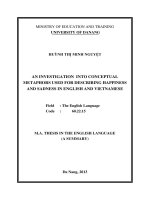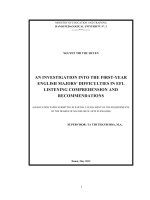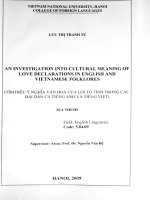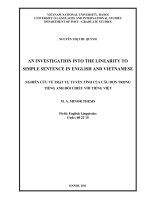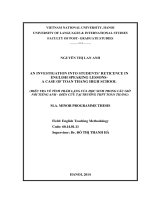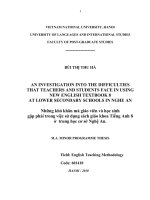An investigation into grammatical metaphor in english and vietnamese political speeches (tt)
Bạn đang xem bản rút gọn của tài liệu. Xem và tải ngay bản đầy đủ của tài liệu tại đây (229.19 KB, 26 trang )
MINISTRY OF EDUCATION AND TRAINING
THE UNIVERSITY OF DANANG
DƯƠNG THỊ MINH HIỀN
AN INVESTIGATION INTO GRAMMATICAL METAPHOR
IN ENGLISH AND VIETNAMESE POLITICAL SPEECHES
Field
Code
: The English Language
: 60.22.15
MASTER THESIS IN SOCIAL
SCIENCES AND HUMANITIES
(A SUMMARY)
Supervisor: Assoc. Prof. Dr. Phan Văn Hòa
Danang – 2014
The study has been completed at the College of Foreign Languages
The University of Danang
Supervisor: Assoc. Prof. Dr PHAN VĂN HÒA
Examiner 1: Nguyễn Quang Ngoạn, Ph.D.
Examiner 2: Hồ Sỹ Thắng Kiệt, Ph.D.
This thesis was defended at the Examining Committee at the
University of Danang.
Time
: 14/12/2014
Venue
: The University of Danang
The original of the thesis is accessible for the purpose of
reference at:
- The College of Foreign Language Library, Danang University.
- The Information Resources Centre, Danang University.
1
CHAPTER 1
INTRODUCTION
1.1.
RATIONALE
Communicating successfully means that people should know
how to use language effectively. To achieve this purpose, lots of
stylistic
devices
such
as
metaphor,
metonymy,
simile,
personification, charactonym, symbol, imagery, etc. are employed.
Among them, metaphor may be one of the most popular devices. It is
easy to realize that metaphor is used widely not only in literature but
also in many other fields such as speeches, newspapers,
advertisements, etc.
More than two thousand years ago, Aristotle, the great ancient
Greece thinker, began the study of metaphors. However, most of the
studies at that time were concerned with metaphorical expressions at
the lexical level of language, but seldom the grammatical level.
Later, some researchers such as Richard (1965), Black (1979),
Lakoff and Johnson (1980) studied metaphors from the cognitive
perspective. Until the 1980s, the study of grammatical metaphor
really began to arouse the great interest of researchers, and the real
beginning of the conscious study of grammatical metaphors began
with Halliday (1985).
Speech, especially political speech, plays an important role in
our lives. In the present-day world political speeches are ubiquitous.
They are present in television, radio, newspapers, political
campaigns or party rallies, meetings lobbying for public support, etc.
To some people, politics is their interest; to others, whether they like
it or not, political issues still come to their awareness somehow.
Political speech is a tool to create or avoid wars. Moreover, through
2
political speeches, speakers can win people’s hearts, persuade and
even change attitudes and opinions of others. Political speeches have
attracted increasingly attention from many researchers. Yet, the
combination of grammatical metaphor and political speeches have
not been addressed. For the above reasons, I decide to carry out the
research: “An investigation into grammatical metaphor in English
and Vietnamese political speeches.”
1.2.
AIMS AND OBJECTIVES
1.2.1. Aims
This research aims at examining the use of metaphorical
modes of expression in English and Vietnamese political speeches
from a systemic functional perspective.
Features of grammatical metaphor used in this speech will be
analyzed following the approach of systemic functional linguistics to
understand the roles of grammatical metaphors in developing and
structuring this discourse.
1.2.2. Objectives
This paper is designed to aim at the following objectives:
- To present some grammatical metaphors used in English and
Vietnamese political speeches.
- To compare the similarities and differences in terms of
grammatical metaphors in English and Vietnamese political
speeches.
1.3.
RESEARCH QUESTIONS
In order to achieve the above-mentioned aims and objectives
the research will seek the answers to the following questions:
-How are grammatical metaphors used in English political
speeches?
3
-How are grammatical metaphors used in Vietnamese political
speeches?
-What are the similarities and differences in terms of
grammatical metaphor in English and Vietnamese political speeches?
1.4.
THE SCOPE OF THE STUDY
This study attempts to look at how grammatical metaphors are
used in English-Vietnamese political speeches.
The analysis will follow Halliday’s work “An Introduction to
Functional Grammar” as the framework and English-Vietnamese
political speeches will be taken as source of data for illustration.
1.5.
THE SIGNIFICANCE OF THE STUDY
This thesis makes an attemp to explore how grammatical
metaphors are used in English and Vietnamese political speeches. It
shows the importance of using grammatical metaphor in discourses
in general and political speeches in particular.
1.6.
THE ORGANIZATION OF THE STUDY
The study is organized into five chapters as follows:
Chapter 1: Introduction
Chapter 2: Literature Review and Theoretical Background
Chapter 3: Methods and Procedures
Chapter 4: Finding and Discussions
Chapter 5: Conclusion, Implications and Limitations
CHAPTER 2
LITERATURE REVIEW AND THEORETICAL
BACKGROUND
2.1.
A REVIEW OF PREVIOUS STUDIES
Grammatical metaphor is a new concept and there haven’t
been many researches related to grammatical metaphor so far. This
4
phenomenon in the language system has been studied by some
linguists such as Anne-Marie Simon-Vadenbergen; Taverniers, M.;
Ravelli, L. (1984), Halliday (1985), Thompson (1996), etc. In
Vietnam, there have been a little books or articles concerned with
this matter, for example, “Danh hoa trong Tieng Viet hien dai” by
Nguyen Thi Thuan, VNU, Hanoi (2003), or “An du so sanh, an du
dung hoc va an du ngu phap”, Ngon ngu hoc va doi song, 4 (150) by
Phan Van Hoa (2008). Besides, some master theses of Vietnamese
learners just related to some aspects of grammatical metaphor such
as “Nominalization in English in Pedagogical Perspective” (2005)
by Doan Thuy Khanh Tram, Da Nang University, “An investigation
into nominalization in English and Vietnamese newspapers as
grammatical
metaphor
device
in
the
functional
grammar
perspective” (2011) by Nguyen Van Vui, Da Nang University.
Nguyen Thi Thanh Huong (2009) studied “An investigation into
linguistic features of interpersonal metaphor in English and
Vietnamese equivalents”.
2.2.
THEORETICAL BACKGROUND
2.2.1.
Metaphor, Lexical Metaphor and Grammatical
Metaphor
a.
Metaphor
We will mention to some of the definitions of metaphor as
follows.
A simplified definition is that metaphor is a “mapping of the
structure of a source model onto a target model” (Ungerer and
Schmid, 1999). This definition has not yet been stated precisely what
a domain is and how a source model is different from the target
model. Although Simpson (2004) has a similar definition, his
5
concept overcomes this shortcoming. He states that “A metaphor is a
process of mapping between two different conceptual domains. The
different domains are known as the target domain and the source
domain. The target domain is the topic or concept that you want to
describe through the metaphor while the source domain refers to the
concept that you draw upon in order to create the metaphorical
construction”.
Without dealing with source domain and target domain,
Halliday (1994) provides an understandable and simple concept of
metaphor as “a word is used for something resembling that which it
usually refers to”.
Consider the following examples:
(1)
“A flood of protests poured in following the announcement”
(2)
“The government still hopes to stem the tide of inflation”
In these two examples, metaphors are “flood….poured in”,
“stem the tide”. They are transferred from concrete senses “a large
quantity…came in”, “resist the force of” to abstract senses.
b.
Lexical Metaphor
The traditional approach to metaphor is to look at it “from
below” as variation in the meaning of a given expression (Halliday,
1994). It means we look at metaphorical movement from a literal to a
figurative meaning.
Taverniers (2004) introduces the definition of lexical metaphor
as “a feature which belongs to the lexicon of a language: it refers to
the possibility of lexemes to express new, metaphorical meanings”.
If analyzing the first example above with traditional view “from
below”, literally, “flood” is “a moving mass of water” and
metaphorically, “flood” is “a moving mass of felling or rhetoric”.
6
c.
Grammatical Metaphor
Another aspect of metaphor is Grammatical Metaphor. This
notion is described by Halliday (1985) in chapter 10 with the title of
this chapter, “Beyond the Clause: Metaphorical Modes of
Expression”. Halliday’s approach relies on the fact that there are
different choices of grammatical structures, congruent and
incongruent ones. Grammatical metaphor is conceived as an
incongruent realization of a given semantic configuration in the
lexicogrammar (Halliday, 1985).
Grammatical metaphor is the expression of a meaning through
a lexicon-grammatical form which originally evolved to express a
different kind of meaning. The expression of the meaning is
metaphorical in relation to a different way of expressing the “same”
meaning which would be more congruent (Thomson, 1996).
Consider the following example:
(3)
John’s writing of a letter to his sister surprised me.
In the example (3), John’s writing of a letter to his sister refers
to a process taking place at a particular time in reality. According to
Halliday, processes are normally expressed by means of a conjugated
verb and a number of participants taking part in the activity, with the
verb and its participants together constituting a full clause. In this
view, the most straightforward encoding of the process referred to in
John’s writing of a letter to his sister is a full clause, such as:
(4)
John wrote a letter to his sister (last week...).
Thus, what is exactly metaphorical, in the example (3)? In
Halliday view, it is the fact that a process (the verb “write” and its
participants, John + a letter + to his sister) is not realized by means of
a clause, but rather by means of another type of form, such as a
7
nominalized phrase, as in the example. In this sense, grammatical
metaphor again involves a type of metaphorical movement: from a
process as clause (the default encoding of a process) to a process as
noun phrase. Grammatical metaphor is thus based on the variation
betwwen something common, standard, default (i.e. a process
realized as a clause) and something which is extended from that (i.e.
a process realized by some other form, e.g a noun phrase). However,
in the case of grammatical metaphor, the two aspects involves in the
movement or metaphorical extension no longer refer to lexemes and
lexical meanings (as with lexical metaphor). Rather, they refer to
grammatical forms, or grammatical means of expression, such as a
clause and a nominal group. These two aspects – (i) the metaphorical
movement and (ii) the variation between grammatical forms –
explain the two parts of the notion “grammatical metaphor”.
In his “Introduction to Functional Grammar”, Halliday pointed
out that grammatical metaphor includes two types: Metaphor of
Mood
(including
Modality)
and
Metaphor
of
Transitivity.
Semantically, these are respectively Interpersonal Metaphor and
Ideational Metaphor.
2.2.2. Ideational Grammatical Metaphor
Ideational grammatical metaphors are called metaphors of
transitivity. It is the grammatical variation between congruent and
incongruent forms. In order to bring out the metaphorical nature of
an incongruent expression, it is compared to an equivalent congruent
realization. The functional analyses of the two expressions are
combined into the single diagram below with a congruent and
incongruent form.
8
Table 2.1. Analysis of Transitivity Metaphors
[9, p.6]
Congruent:
Mary
saw
something wonderful.
Participant:
Process:
Participant:
senser
mental: perceptive
phenomenon
Incongruent:
Mary
came
upon a wonderful sight.
Participant:
Process:
Circumstance:
actor
material
location
Thanks to the analysis the grammatical variation of the two
congruent and incongruent forms in the vertical dimension, we can
realize clearly the differences between them. In the congruent form,
the participant changes to actor; the process to material and the
phenomenon to location.
9
2.2.3. Interpersonal Grammatical Metaphor
Interpersonal metaphor is a fairly undeveloped area in
Systemic Functional Language, but Halliday [2] has prepared the
ground for further investigation on the topic. According to the two
theorists, interpersonal metaphors arise from the Mood and Modality
system of language.
Halliday defined interpersonal metaphor is one kind of
grammatical metaphor, in the expression of mood and modality
related to the speaker’s opinions. The interpersonal type of metaphor
in Halliday’s theory is especially concerned with the example: I
don’t believe that pudding ever will be cooked”, expressing the
modality “in my opinion....not likely” in the form of a Head clause I
don’t believe, and the thesis “that pudding will be cooked” in the
form of a dependent Modifying clause. That this is metaphorical
construction can be seen from the fact that the “tagged” form
would be “I don’t believe that pudding ever will be cooked, will it?”
(not I don’t believe that pudding ever will be cooked, do I? as it
would be if the example was to be interpreted congruently. The
expression I don’t believe is functioning as an interpersonal (modal)
Theme. Other examples are: I dare you say you’ll see her soon, I
think I’ll go and meet her, Do you suppose that they could get it
clear?- where the similarly the tags would be won’t you?, Shall
I?, and could they?
[2]
Halliday presents the structure of interpersonal metaphor in a way
that brings out the metaphoric element in its modal structure.
a. Metaphor of Modality
This is a very common type of interpersonal metaphor, based
on the semantic relationship of projection. In this type the speaker's
10
opinion regarding the probability that his observation is valid is code
not as a modal element within the clause, which would be its
congruent realization, but as a separate, projecting clause in a
hypotactic clause complex. To the congruent form it probably is so
corresponds the metaphorical variant ‘I think it is so’, with ‘I think’
as the primary or ‘alpha’ clause. The reason for regarding this as a
metaphorical variant is that the proposition is not, in fact, ‘I think’;
the proposition is ‘it is so’.
b.
Metaphor of Mood
The other main type of interpersonal metaphor is that
associated with Mood. Mood expresses the speech function, the
underlying pattern of organization here is the exchange systemgiving or demanding information or good-&-services, which
determine four basic speech functions of statement, question, offer
and command.
11
CHAPTER 3
METHODS AND PROCEDURES
3.1.
RESEARCH DESIGN
3.2.
SAMPLING
3.3.
DATA COLLECTION
3.4.
DATA ANALYSIS
3.5.
RELIABILITY AND VALIDITY
CHAPTER 4
FINDING AND DISCUSSIONS
4.1.
IDEATIONAL
METAPHOR
IN
ENGLISH
AND
VIETNAMESE POLITICAL SPEECHES
4.1.1. Types of Ideational Metaphor in English and
Vietnamese Political Speeches
After analyzing samples of English and Vietnamese political
speeches based on the table of types of grammatical metaphors
(Halliday & Matthiessen, 1999), we have found that the major types
used in English political speeches are type 1 (quality → thing), 2
(process → thing), 3 (circumstance → noun), 5 (process → quality)
and 13 (thing → modifier of thing). In terms of Vietnamese political
speeches, the most common types are type 1 (quality → thing), type
2 (process → thing) and 13(thing → modifier of thing).
Here are some instances of grammatical metaphor in English
and Vietnamese political speeches:
(1) It’s an honor for me to be here.
Congruent form: I am honorable to be here.
Grammatical/semantic shift: adjective/quality (honorable)
noun/thing (honor)
12
(2) Những điều đó chỉ tỏ rõ cái yếu, cái dốt, cái vụng của mình.
Congruent form: Những điều đó chỉ tỏ rõ (là) mình yếu, dốt,
vụng.
Grammatical/semantic shift: adjective/quality (yếu, dốt, vụng)
noun/thing (cái yếu, cái dốt, cái vụng)
After collecting and analysing samples, we find that in English
and Vietnamese political speeches, nominalization makes up the
largest part, 88% for English political speeches and 76% for
Vietnamese ones. In fact, Halliday (1994) stated that “nominalization
is the single most powerful resource for creating grammatical
metaphor”. In addition, we find that nominalization in English and
Vietnamese political speeches mainly includes de-verbal, deadjectival and conversion.
4.1.2. Nominalization of the Process
(3a) America’s belief in human dignity will guide our policies, yet
rights must be more than the grudging concessions of dictators. [35]
The Thing belief can be nominalized from:
(3b) That America believe in human dignity will guide our policies,
yet rights must be more than the grudging concessions of dictators.
(4a) Tầm nhìn sau 2015 phải giúp đưa Cộng đồng ASEAN vì phúc lợi
người dân, khơi gợi ý thức cộng đồng và khuyến khích sự tham gia
tự nguyện, tích cực của người dân vào tiến trình này.
[45]
The Thing sự tham gia can be nominalized from the Event
(4b) Tầm nhìn sau 2015 phải giúp đưa Cộng đồng ASEAN vì phúc
lợi người dân, khơi gợi ý thức cộng đồng và khuyến khích người dân
tham gia một cách tự nguyện, tích cực vào tiến trình này.
13
4.1.3. Nominalization of the Quality
(5) The truth is, on issue after issue that would make a difference in
your lives - on health care, and education, and the economy -Senator McCain has been anything but independent.
[39]
The truth is...can be rewritten as It is true that and make a
difference in your lives can be rewritten as make your lives different.
(6) Tôi tin chắc rằng, với sự lịch thiệp và đối xử thân tình của mình,
đồng bào có thể tranh thủ được sự quý mến và cảm tình của nhân
dân Pháp đối với nước Việt Nam ta.
[28, p.74]
The noun phrase sự lịch thiệp của mình (của đồng bào) can be
nominalized from the clause đồng bào lịch thiệp (you’re polite)
However, if we want to replace the clause đồng bào lịch thiệp
for sự lịch thiệp của đồng bào, we have to add a nominalizer such as
“việc” to the clause đồng bào lịch thiệp and the clause đồng bào lịch
thiệp now becomes a noun or a relative clause việc đồng bào lịch
thiệp functioning as the Subject in the following sentence: “Tôi tin
chắc rằng, việc đồng bào lịch thiệp và đối xử thân tình có thể tranh
thủ được sự quý mến và cảm tình của nhân dân Pháp đối với nước
Việt Nam ta.”
4.1.4. Nominalized Verbs and Adjectives by Using
Conversion
- Nominalized verbs by using conversion:
(7) My call tonight is for every American to commit at least two
years — 4,000 hours over the rest of your lifetime — to the service of
your neighbors and your nation.
[35]
14
(8) ASEAN chúng ta cũng cần đẩy mạnh các nỗ lực nhằm ứng phó
hiệu quả đối với các thách thức an ninh phi truyền thống đang nổi
lên, bao gồm các thách thức môi trường, nguồn nước, thiên tai, biến
đổi khí hậu, dịch bệnh...
-
Nominalized
[46]
adjectives
by
using
conversion:
this
phenomenon just happens in Vietnamese.
(9) Ngoài ra, chúng ta còn cần phải cần kiệm bỏ hết mọi xa xỉ để lấy
tiền cống hiến cho quỹ kháng chiến.
[28, p.31]
As we mentioned and analysed in the above section, the
priority to using nominalization as in type 1 (qualitything) and
type 2 (processthing) in English and Vietnamese political speeches
is the important reason for making language powerful and
persuasive. Firstly, by “nouning” a process, the speakers can reflect a
fact, or express the meaning which can be treated as existing.
Secondly, it helps them to develop their arguments step by step,
using complex passages “packaged” in nominal form. Thirdly, it
allows processes to be objectified, to be expressed without the
human doer.
4.2.
INTERPERSONAL METAPHOR IN ENGLISH AND
VIETNAMESE POLITICAL SPEECHES
4.2.1. Syntactic Features of Interpersonal Metaphor in
English and Vietnamese Political Speeches
4.2.1.1. Syntactic Features of Modality in English and
Vietnamese Political Speeches
The syntactic features of modality is the projection clause. In
this type, the speaker’s opinion regarding the probability that his
15
observation is valid is coded not as a modal element within the
clause, which would be its congruent realization, but as separate,
projecting clause in hypotactic clause nexus. The following samples
will illustrate the above idea:
(10) I believe, as I always have, that we will rise to this moment, we
will build something better for our children, and we will secure
America’s future in this new century.
[34]
(11) I don’t believe that government can or should run health care.
But I also don’t think insurance companies should have free reign to
do as they please.
[34]
What is more, the projection clause in English political
speeches includes a mental clause and an idea clause. It means that
the clauses containing I think, I don’t think, I thought, I know, I
believe, I imagine, I trust are mental clauses (MC) and the after
clauses are idea clauses (IC). For examples:
(12) I know many Americans feel fear today.
[35]
In Vietnamese, syntactic feature of modality is similar to that
in English in the term of projection clause. The metaphorical
elements of probability in Vietnamese political speeches are
expressed in verbal clauses such as: “Tôi tin rằng, tôi thiết tưởng,
ta tin chắc, họ tưởng rằng, nghe nói, các bạn đều biết rõ, như các vị
đều biết, theo ý chúng tôi...” Those are the similarities of projecting
clauses in English and Vietnamse language. Modality in Vietnamese
political speeches also include a mental clause and an idea clause.
(13) Ta tin chắc ta thắng lợi.
[29, p.178]
16
4.2.1.2. Syntactic Features of Mood in English and
Vietnamese Political Speeches
Syntaxtic features of
mood
presented
as
declaratives
(giving information), interrogatives (demanding information), and
imperatives (expressing demands or offers). Below is the list of some
examples to illustrate:
Declaratives
(14) But to all of you who lost someone here, I want to say: You are
not alone.
[35]
(15) Dân tộc ta là một, nước Việt Nam là một.
[29, p.325]
Imperatives
(16) Don't tell me that Democrats won't keep us safe.
[39]
(17) Toàn thể đảng viên và cán bộ ta hãy quyết tâm theo đúng kỷ
luật của Đảng.
Interrogatives
(18) Why else would he define middle-class as someone making
under five million dollars a year?
[39]
(19) Nếu quyền lợi của dân tộc không còn, quyền lợi và sự nghiệp gì
của cá nhân liệu có giữ được an toàn không?
[28, p.29]
4.2.2. Semantic Features of Interpersonal Metaphor in
English and Vietnamese Political Speeches
4.2.2.1. Semantic Features of Modality in English and
Vietnamese Political Speeches
a. Probability
(20) And sometimes our differences run so deep, it seems we share a
continent, but not a country.
[35]
17
The probability in interpersonal metaphor includes words such
as: certainly, probably, possibly, perhaps, seem, might (not), may
(not),… The reason for regarding those as metaphorical variant is
that the proposition is not, in fact, ‘ I think’; the proposition is
‘it is so’.
In Vietnamese, the metaphorical elements of probability are
expressed in words such as: có lẽ, có thể, chắc, chắc chắn, không
nghi ngờ,...
(21) Đường xa nhưng lòng không xa, tôi chắc rằng nhân dân hai
nước chúng ta đều đồng một lòng yêu chuộng hòa bình, do đó mà
chúng ta càng ngày càng hiểu biết nhau và gần gũi nhau.
[29, p.2]
b. Usuality:
The degree of usuality presented in English political
speeches by the adverbs of frequency such as always, usually,
sometimes, never...
(22) America has never been united by blood or birth or soil.
[35]
(23) Đảng ta luôn luôn giương cao ngọn cờ của chủ nghĩa yêu nước
và chủ nghĩa xã hội.
[29, p.305]
c. Obligation:
(24) We must comfort the sick. We must care for the aged.
(25) Do đó, nhiệm vụ các bạn phải tuyệt đối trung thành với chính
quyền dân chủ.
d. Inclination:
(26) You're determined to build a better future.
[28, p.275]
18
(27) Chúng ta nhất định thành công trong sự nghiệp xây dựng một
nước Việt Nam hòa bình, thống nhất, độc lập, dân chủ và giàu mạnh.
[29, p.94]
4.2.2.2. Semantic Features of Mood in English and
Vietnamese political speeches
a. Affirming
(28) I pledged to honor our Constitution and laws.
[35]
(29) Và tôi cam đoan rằng Tổ quốc, đồng bào và Chính phủ bao giờ
cũng khoan hồng.
[28, p.169]
b. Requesting
(30) We ask every nation to join us.
[35]
(31) Vì vậy tôi đề nghị mở một chiến dịch để chống nạn mù chữ.
[28, p.2]
c. Declaring
(32) And I want you and your families to know: America is proud of
you.
[35]
(33) Chúng tôi muốn độc lập và thống nhất.
[28, p.117]
d. Promising
(34) I can promise, too, that America will join the world in helping
the people of Afghanistan rebuild their country.
[35]
(35) Tôi hứa rằng Chính phủ sẽ khen thưởng xứng đáng những đồng
bào thi đua có kết quả trội nhất.
[28, p.434]
e. Undertaking
(36) For these commitments, we are determined to fight.
[35]
(37) Nhân dân ta từ Bắc đến Nam đều kiên quyết đấu tranh.
[29, p.36]
19
f. Warning
In the English political speeches, “if” is often used to express
warnings.
(38) If Iraq’s regime defies us again, the world must move
deliberately, decisively to hold Iraq to account.
[35]
In Vietnamese, the words: “nếu...thì”, “chớ”, “còn phải”, etc.
are used to express warnings.
(39) Cho nên, nếu phe đế quốc Mỹ điên cuồng mà phát động chiến
tranh, thì chúng nhất định sẽ thất bại.
4.2.2.3.
Subjective
and
[29, p.36]
Objective
Features
of
Interpersonal Metaphor in English and Vietnamese political
speeches
It is certain that both English and Vietnamese political
speeches have their own objective feature in interpersonal metaphor
which enables them to be more colorful and meaningful.
(40) I hope Americans will continue to pray that everyone in my
administration finds wisdom, and always remembers the common
good.
[35]
(41) Các em cũng nên tham gia vào các Hội cứu quốc để tập luyện
thêm cho quen với đời sống chiến sĩ.
[28, p.18]
The following part is to show the subjective feature of
interpersonal metaphor in English and Vietnamese political speeches.
(42) We know they have this mad intent, and we’re determined to
stop them.
(43) Chúng ta quyết không chịu làm nô lệ.
[35]
[28, p.291]
20
4.2.2.4. Explicit and Implicit Features in Interpersonal
Metaphor in English and Vietnamese political speeches
a. The Explicit Feature
As we mention in the theoretical background, the explicit
feature in interpersonal metaphor presented in subjective and
objective. Based on the examples by Halliday (2, p. 616), we
would like to raise some other illustrations.
(44) I do not believe that any of us would exchange places with any
other people or any other generation.
[37]
For this example, we can understand that there are two
possibilities in each of the explicit form. The subjective explicit are:
“I believe that none of us would exchange places with any other
people or any other generation.”/ “ I do not believe that any of us
would exchange places with any other people or any other
generation.” And the objective explicit are: “It’s likely that none of
us would exchange places with any other people or any other
generation.”/ “ It isn’t likely that any of us would exchange places
with any other people or any other generation.”
In comparision to Vietnamese political speeches, the
metaphorical features of explicit appear in the following examples:
(45) Tôi mong đồng bào cố gắng.
[28, p.353]
(46) Ta quyết không vì thắng mà chủ quan khinh địch.
[28, p.578]
21
b. The Implicit Feature:
Subjective:
Subjective:
Objective:
explicit
implicit
implicit
Objective:
explicit
I believe that in this In this generation
In this generation
It’s likely that in
generation those
those with the
this generation
those with the
with the courage to courage to enter the courage to enter the those with the
Modalization:
probability
enter the conflict
conflict will find
conflict will
courage to enter the
will find
themselves with
probably find
conflict will
themselves with
companions in
themselves with
probably find
companions in
every corner of the companions in
themselves with
every corner of the world.
every corner of the companions in
world.[42]
world. [in all
every corner of the
probability]
world. [it is likely
to]
Modalization:
usuality
Dollars alone won’t Dollars alone do
It’s not always for
make
not always make
dollars to make the
the difference.
the difference. [35] difference.
22
Modulation:
obligation
Subjective:
Subjective:
Objective:
explicit
implicit
implicit
It’s expected
You should
You’re
remember these
remember these
supposed to
that you
goals. [35]
goals.
remember
remember these
these goals.
goals.
Modulation:
I will rebuild our
I’m keen to
inclination
military to meet
rebuild our military
future conflicts.
to meet future
SUMMARY
explicit
I want you to
[39]
4.3.
Objective:
conflicts.
23
CHAPTER 5
CONCLUSIONS, IMPLICATIONS AND LIMITATIONS
5.1.
CONCLUSIONS
This thesis aims at examining the use of grammatical
metaphor in English and Vietnamese political speeches. After
studying, we recognized that both ideational and interpersonal
metaphors appeared densely.
In ideational metaphor, based on the table of types of
grammatical metaphors in English, we found that the major types of
ideational metaphors that are used are type 1 (qualitything), type 2
(processthing), type 6 (circumstancenoun), type 5 (process
quality)
and type
13
(thingmodifier
of thing). Thus,
nominalization plays an important role in the politician’s
metaphorical modes of expression. This phenomenon helps the
speaker to reflect a fact, to develop the argument step by step, using
complex passages “packaged” in nominal form as theme and makes
the processes in the speeches objectified. Moreover, we recognized
that metaphorical clauses with nominalization are always shorter
than congruent clauses.
In interpersonal metaphor, we studied the speeches in two
aspects: metaphor of mood and metaphor of modality. Firstly, in
terms of syntax, interpersonal acts similarly in English and
Vietnamese political speeches. The projection clause occurs as a high
rate and includes two main parts: Mental clause and Ideational
clause. Secondly, in terms of semantics, there are some differences
due to the lexical of two languages and their position as well as the
combination in two main types of interpersonal metaphor. Thirdly,
for occurrence frequency, Probability a n d Obligation occur with



